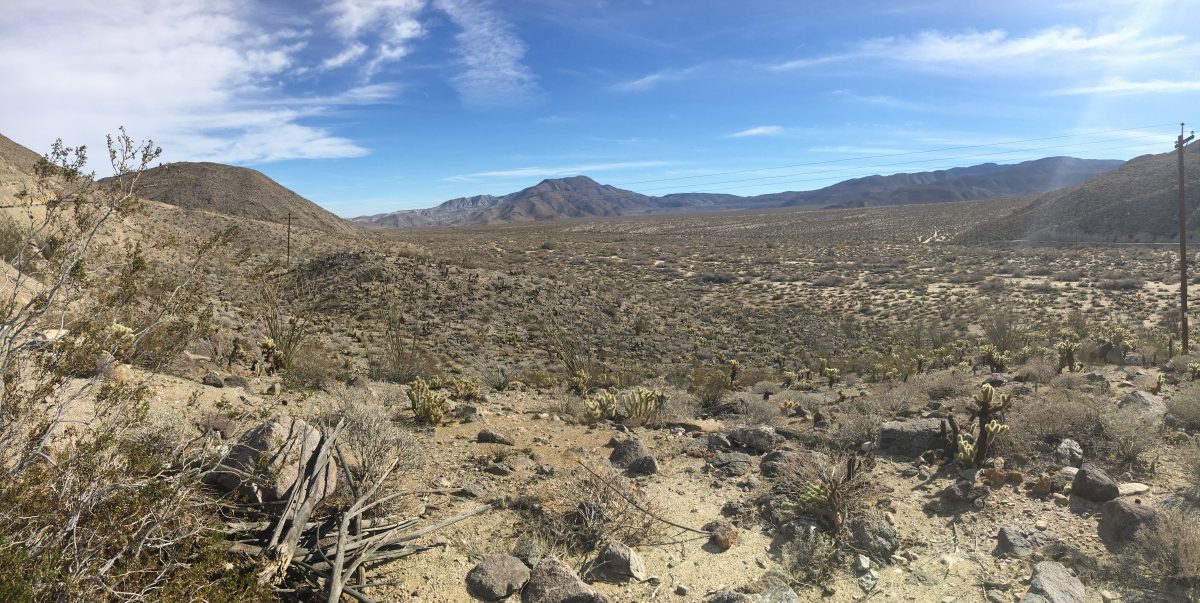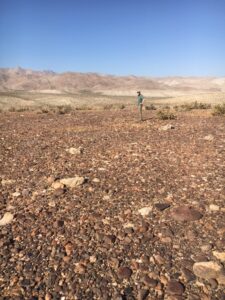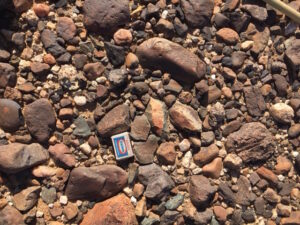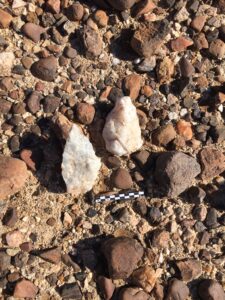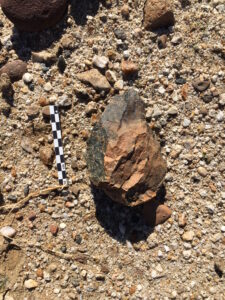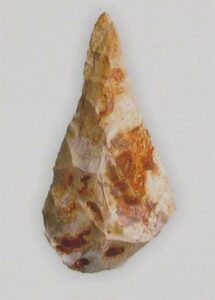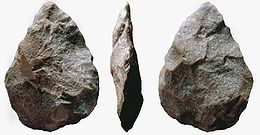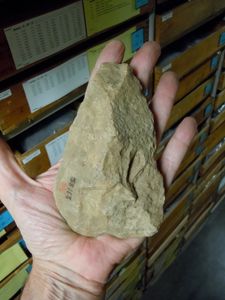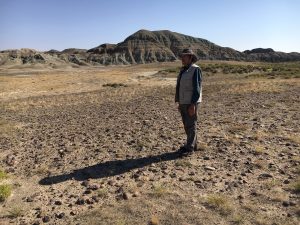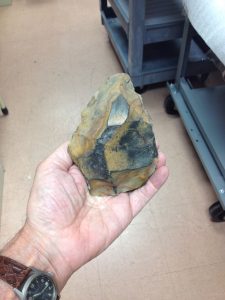The Heinrich Schliemann Papers are one of many treasures in the Archives of the American School of Classical Studies at Athens. The collection was started a century ago with a gift of Schliemann letters from the architect Francis H. Bacon. It became a true archive in 1936 with gifts from Schliemann’s children, Andromache and Agamemnon, that included personal documents, diaries, notebooks, manuscripts, correspondence, financial documents, expenditure books, scrapbooks, newspaper clippings, and photographs amongst other materials. Today, materials continue to be added to the collection and scholars from around the world consult the archive as research on Heinrich Schliemann grows and evolves and as digitization makes the archive more accessible to those who are unable to travel to Athens.

Schliemann’s English edition of Troy (left) and Evans’ book on stone implements (right)
The Schliemann archive is invaluable for the proper evaluation of his achievements and contributions to archaeology, especially as Schliemann’s reputation has undergone dramatic changes since his death in 1890. During his lifetime, Schliemann’s reputation was positive, even heroic, and he was especially popular in the United Kingdom and the United States. His reputation continued to grow for much of the twentieth century. Schliemann oftentimes received extravagant praise, for example being described as the “Father of Mediterranean Archaeology” (Traill 1995: 301). Such an accolade was not based on critical examination of his life and work, but echoed instead Schliemann’s own estimate of his accomplishments as described in the autobiographical introductions to his later published works and in an autobiographical sketch published by Sophie Schliemann after his death (S. Schliemann 1892). Schliemann’s reputation changed dramatically in the 1970s with new scholarship by several scholars, especially David Traill, William Calder, and Donald Easton. These scholars used the Schliemann papers in the archive to re-assess Schliemann’s career and produced a radical reinterpretation of Schliemann as a bumbling amateur, a pathological liar, a thief, and—perhaps worst of all—a scoundrel who faked artifacts and salted his excavations in an effort to deceive. Schliemann’s reputation plunged as a result of this revisionist scholarship and his name seemed on the way to becoming a byword for archaeological mendacity and fraud. Since 1990 this harsh picture of Schliemann’s reputation has changed as new research occasioned by the centennial of his death has thrown new light on Schliemann’s life and work, a reassessment that continues to be informed by the careful study of his papers in the archive. Scholars have debunked, for example, many of the claims of fraudulent behavior such as the one that Schliemann salted his excavation of the Shaft Graves at Mycenae with a faked gold Death Mask of Agamemnon (Dickinson 2005). In addition, study of his diaries and letters shows that most of the more unsavory aspects of his personality and life are either untrue, exaggerated, or at least largely irrelevant to his archaeological work (see the chapters in Hellmayr 2021 for re-evaluations).
 \
\
Front cover of Evans’ book on stone implements

Gift inscription by John Evans in Schliemann’s copy of his book on stone implements

Illustrations in Evans’ book on stone implements
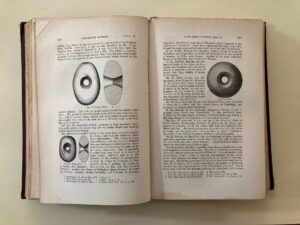
More illustrations in Evans’ book
I have been involved in a small way in “rehabilitating” Schliemann’s reputation by focusing on the history of his excavation reports which show an evolving professionalism over time as Schliemann shed his earlier uncritical enthusiasms and adopted a more rigorous and scientific approach to the interpretation of the results of his excavations (Runnels 2007, 2020). The increasing rigor of his scholarship during his 20-year career can be seen in the physical form and content of the books he published detailing the results of digging and analysis. The beginning of Schliemann’s true professional publication efforts can be traced to London in 1875, and one book may help to illustrate the tale.
The story goes like this. In 1875, not long after the discovery of Priam’s Treasure at Hisarlik and at the height of the public and scholarly enthusiasm—and controversy—about the identification of Homer’s Troy, Schliemann visited London to lecture before the Society of Antiquaries. In a later engraving (1877), we see a similar scene: Schliemann reading a paper before a packed crowd of antiquaries, including the Prime Minister of the United Kingdom, William Gladstone. He was warmly received in the United Kingdom by scholars and the public alike. While he was in London he also worked with the publisher John Murray to publish an English translation of his first report on the Trojan excavations. This book was published in 1875 under the title Troy and Its Remains. In my view Schliemann’s positive reception at the Society of Antiquaries and the subsequent publication of Troy and Its Remains are connected. Among the scholars at Schliemann’s lectures was Sir John Evans, perhaps Britain’s most famous archaeologist, and also father of Sir Arthur Evans. John Evans may have been responsible—directly or indirectly—for Schliemann’s choice of formats for his first English archaeological publication. In 1875, John Evans was a pioneer in the presentation of archaeological data in print and it is probable that he encouraged Schliemann to adopt a “modern” mode of archaeological publication. The two men certainly knew each other, as attested by Joan Evans in her account of her half-brother Arthur, who met his father’s “acquaintance, Henry Schliemann” when Arthur was a young man (Joan Evans 1943: 299).
Front cover of Schliemann’s Troy

Title page to Schliemann’s original German publication of Troy

Front cover to Schliemann’s German Troy
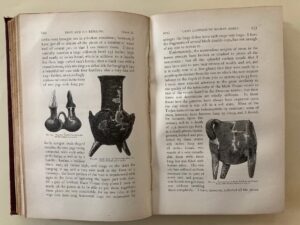
Illustrations in Schliemann’s English edition of Troy
To understand the significance of the selection of a new publication format, we must examine Schliemann’s first attempt at formal archaeological publication. After three seasons of excavation at Hisarlik capped, as Schliemann believed, by the discovery of Priam’s Treasure, he needed to present his findings and arguments to scholars and the public in order to support his identification of Hisarlik as Homer’s Troy. Ever the entrepreneur and innovator, Schliemann decided on a bold format and ambitious even radical plan of publication. He chose to present a bare-bones narrative report of the excavations as a small volume published in German in Leipzig by Brockhaus with the title Trojanische Alterthümer. This book had 319 pages of text but no illustrations. The all-important images of artifacts as well as views of the site and its stratigraphy were published separately in a large album titled the Atlas Trojanischer Alterthümer. The illustrations in the Atlas were original photographic prints, some being photographs of artifacts and others photographs of drawings and plans, and each copy of the Atlas (there were 500 copies in German and French) had 218 photographs mounted by hand largely by Schliemann and his wife Sophia. This achievement required the handling of more than 100,000 photographs. It is among the first archaeological reports to be illustrated with original photographs and like many an innovative idea this one did not work out as planned. Schliemann was dissatisfied with the quality of the photographs which range from poor to execrable in quality with some images hardly visible at all. The separation of the narrative text from the photographic evidence was another problem. It was hard to use the text volume and the photo atlas together as they were of different sizes and the images are not keyed to the text. Cross referencing was difficult, especially as crucial information, such as the depths within the site where the artifacts were found, was lacking. The small print run also resulted in the very limited distribution of the books, which are today exceedingly rare (Runnels 2007). Unsurprisingly, Trojanische Alterthümer and the Atlas were neither a popular nor a commercial success. As he would do in his business ventures and his personal life, when one venture failed Schliemann pivoted and tried something else. And this is what he chose to do with his English translation of Troy and Its Remains in 1875.

More illustrations in Schliemann’s English Troy
Now we return to London and Sir John Evans. Recently, while preparing an article for a publication tied to the observance of the bicentennial of Schliemann’s birth, I highlighted a connection between Schliemann and Evans (Runnels 2021). The connection is based on a book from Schliemann’s personal library that is presently in my collection of Schliemann memorabilia and books (a promised gift to the Archives and the Gennadius Library of the American School of Classical Studies at Athens). I acquired my book in 1995 from an antiquarian bookseller in Oakland, California, who obtained it from the Swedish archaeologist Åke Åkeström who had purchased it in Athens in 1964 along with other books from Schliemann’s library. The book is titled Ancient Stone Implements, Weapons, and Ornaments, of Great Britain and the author is Sir John Evans who, according to an inscription on the half title presented this copy to “Dr. Schliemann, F.S.A. [Fellow of the Society of Antiquaries].” The book is 24 centimeters tall and has 640 pages with 476 engraved illustrations of stone artifacts integrated in the text and two folding plates with artifact drawings at the end. This method of publication used consistent artistic conventions selected by Evans for representing the appearance of the artifacts in the engravings. Importantly, the illustrations are integrated in the text at the place where the artifacts are discussed. This arrangement made this handsome book eminently useful for the scholar and general reader and it became the standard style for archaeological publications for the next century. While it is probable that this book was presented by Evans to Schliemann in 1877 when Schliemann was elected a Fellow of the Society of Antiquaries, it is additional evidence that they communicated professionally for several years.

Scliemann’s Troy
I see no reason to doubt that Schliemann’s first English book Troy and Its Remains was influenced by the format of Evan’s book on Stone Implements, Weapons, and Ornaments. Side by side the relationship is self-evident. Troy and Its Remains looks like Evan’s book: it is 24 centimeters tall with 392 pages with 300 engraved illustrations integrated in the text with the addition of folding lithographic plans and 52 plates of artifact drawings at the end. The bindings of the books are similar in color and both bindings have gilt images of antiquities on the front cover. The most significant change from Schliemann’s first effort at publishing archaeological evidence is seen in the illustrations. While actual photographs may seem like a good idea, the means of making good prints and of placing them in large print runs of books were still a work in progress in Schliemann’s day. So in 1875 Schliemann replaced the photographs with engravings made from photographs and positioned them where they appeared alongside their discussion in the text. Depths of findspots in the excavations were also added. As David Trail notes it “was a much more convenient and attractive book than either the German or French editions [and that] S was delighted [with the result, remarking that] ‘the volumes before me are beyond all praise’” (Trail 1995: 135). Like Evan’s book, Troy and Its Remains is good looking, compact, and easy to use. Not surprisingly it was an immediate popular, professional, and commercial success.
In brief, I conclude that Schliemann discussed with Evans the best way to publish archaeological data and took the advice of the more experienced archaeologist (a pattern followed throughout his career) and adopted the standard format of Evans’ 1872 publication to ensure the proper quality of production and guarantee that the book would receive a positive reception. Troy and Its Remains was the first in a long series of increasingly professional archaeological books in the same format that would issue from Schliemann’s pen over the next fifteen years. Indeed, it is probable that the new format adopted by Schliemann for his books in 1875 was helpful in establishing his popularity amongst readers at all levels, securing his reputation as perhaps “the emblematic archaeologist of all time” (Traill 1995: 306).
Bibliography
Dickinson, Oliver T. P. K., 2005, “The ‘Face of Agamemnon’,” Hesperia 74: 299–308.
Evans, John, 1872, The Ancient Stone Implements, Weapons, and Ornaments, of Great Britain. Longman, Green, Reader, and Dyer: London.
Evans, Joan, 1943, Time and Chance: The Story of Arthur Evans and His Forebears. Longmans, Green and Co.: London
Hellmayr, Leoni, ed., 2021, Heinrich Schliemann und die Archäologie. Philipp von Zabern: Darmstadt.
Runnels, Curtis, 2020, “Heinrich Schliemann,” in Corinne Ondine Pache, ed., The Cambridge Guide to Homer. Cambridge University Press: Cambridge, pp. 381-383.
Runnels, Curtis, 2021, “Mehr als ein Laie: Schliemanns Bücher liefern den Beweis” in L. Hellmayer, ed., Heinrich Schliemann und die Archäologie. Philipp von Zabern: Darmstadt, pp. 69-77.
Schliemann, Heinrich, 1874, Trojanische Alterthümer: Bericht über Die Ausgrabungen in Troja. F. A. Brockhaus: Leipzig.
Schliemann, Henry, 1875, Troy and Its Remains: A Narrative of Researches and Discoveries Made on the Site of Ilium and in the Trojan Plain. John Murray: London.
Schliemann, Sophie, 1892, Heinrich Schliemann’s Selbstbiographie. Brockhaus: Leipzig.
Traill, David. A., 1995, Schliemann of Troy: Treasure and Deceit. St. Martin’s Press: New York.
